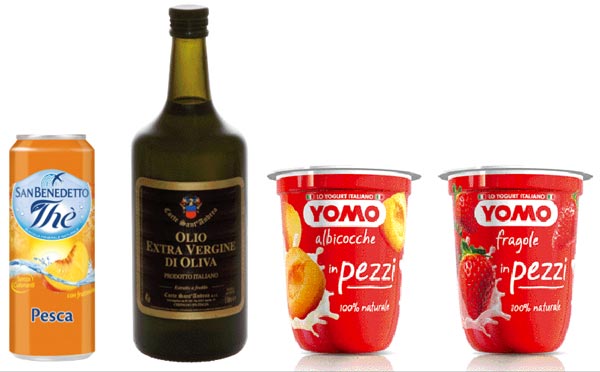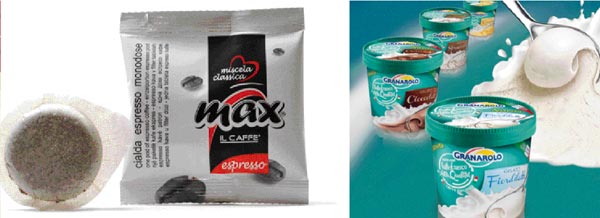The food industry in Italy – Data 2011
FOOD AND BEVERAGE Structure and market trends. Focus on packaging of food products.
The Italian food industry for many years has shown growth trends that on average exceed those of global manufacturing.
From 2000 to 2011, according to Ismea’s calculations, production in the food sector overall, beverages included, has grown by a total of 10.4%, in the face of a 15.2% decline in the manufacturing industry as a whole. This confirms the anti-cyclical trend of the food industry, at least since the first half of 2011.
Unfortunately, since the last months of 2011, this characteristic has begun to show vulnerabilities, especially in relation to domestic demand, which have led in 2011 to a net drop in total consumption of 1.7%, bringing average values in food consumption back down to those reached during the 2-year crisis period of 2008/2009.

Also according to Ismea, the areas of largest decline in domestic demand have affected in particular baking goods (-5%), the milled products sector (-2/-3%) and that of olive oil and seeds (-1.8/2%).
Over the long term, food exports have shown good progress, decidedly better than that of domestic demand.
Also according to Ismea’s findings, between 2000 and 2011, food industry exports reached accumulated growth of 87% in value, compared to 44% growth of total exports for the Italian manufacturing industry.
In 2011, exports reached 23 billion euro out of a total turnover of 127 billion (18% of production).
The best performances in exports were reached by wine, beer, the milk/dairy sector, olive oil, coffee and pet food.
The markets that yielded the best results were Russia, China, Brazil, South Africa, Hungary, the Czech Republic and Austria.
Considering production of the main food areas, in 2011 the sector grew overall, although with a progressively slowing trend since the fourth quarter; however, following substantial growth up until the summer, it managed to record a slight increase estimated around 1%.
Production trends. Acccording to the findings of Istituto Italiano Imballaggio, 2011 production of the main areas showed the following trends:
- slight shrinkage of approximately 1% for vegetable preserves, legumes, tomato products, oil and vinegar preserves etc.;
- 2.6% growth for fish preserves, tuna, sardines etc.;
- positive trend, although slightly mitigated, of 2.5-2.6% for ready sauces;
- the area of various sauces (mayonnaise, mustard etc.), chocolate spreads and baby food remains substantially stable at +1.4-1.6%;
- after a promising beginning to the year, the beverage sector has progressively slowed down its growth following the re-scaling of demand, but thanks to exports it ended the year with positive growth;
- 2.5% production growth for alcoholic products, where the growth has been driven mainly by wine and beer, which achieved excellent exports growth;
- slight increase (0.5-0.7%) for non-alcoholic beverages, mineral water, carbonated drinks, fruit juices etc., due to exports because domestic demand in general declined during this time.
Packaging
Given the diversity of product types, packaging for food products (food and beverage) presents a significant variety of solutions: considered the communication tool par excellence, this sector is also undergoing frequent and significant variations.
The present analysis analyzes packaging, keeping separate the areas of food and and beverage, the latter of which can be further divided between alcoholic and non-alcoholic beverages.
Calculations relating to the use of packaging for packng the various products are based on the database of Istituto Italiano Imballaggio, which, it is estimated, represents approximately 70% of the food area and about 90% of the beverage area.

Food + beverage area
In 2011, handling of the total production of the sectors monitored by Istituto Italiano Imballaggio in the food area involved the use of approximately 2,727 t/000 of packaging. This includes both disposable and re-usable packaging, and primary, secondary and transport packaging.
Compared with 2010, the use of packaging has seen a slight increase of around 0.4%.
Between 2011 and 2010, the majority of the various packaging product types underwent a general reduction in average weight. Closer analysis of the development of the various packaging categories reveals diverging trends.
Metal. Metal packaging has declined slightly. Steel packaging has seen a drop, mainly caused by the significant decline of two important outlet sectors, namely tomato products and chemical products; the drop also depended on a slight decrease in participation in these two sectors. As for aluminium packaging, its use fell by about 5%, due, in addition to the general economic crisis, to a reduction in the production of aluminium cans for beverages, a substantial dislocation of acquisitions from Italy to abroad.
Plastic. Plastic packaging shows 2.6% growth, determined mainly by flexible polylaminates for converting, where the biggest leaps forward concern multi-layer films.
Paper. Cellulosic packaging in 2011 confirmed, for the sectors examined, substantial stability of use; the use of folding boxes, in particular, has grown.
Glass. The use of glass packaging has grown, in particular with regard to bottles thanks to the positive growth trend recorded in the beer and wine sectors.
Wood. The use of wood remained for the most part stable.
Plinio Iascone
Istituto Italiano Imballaggio




















